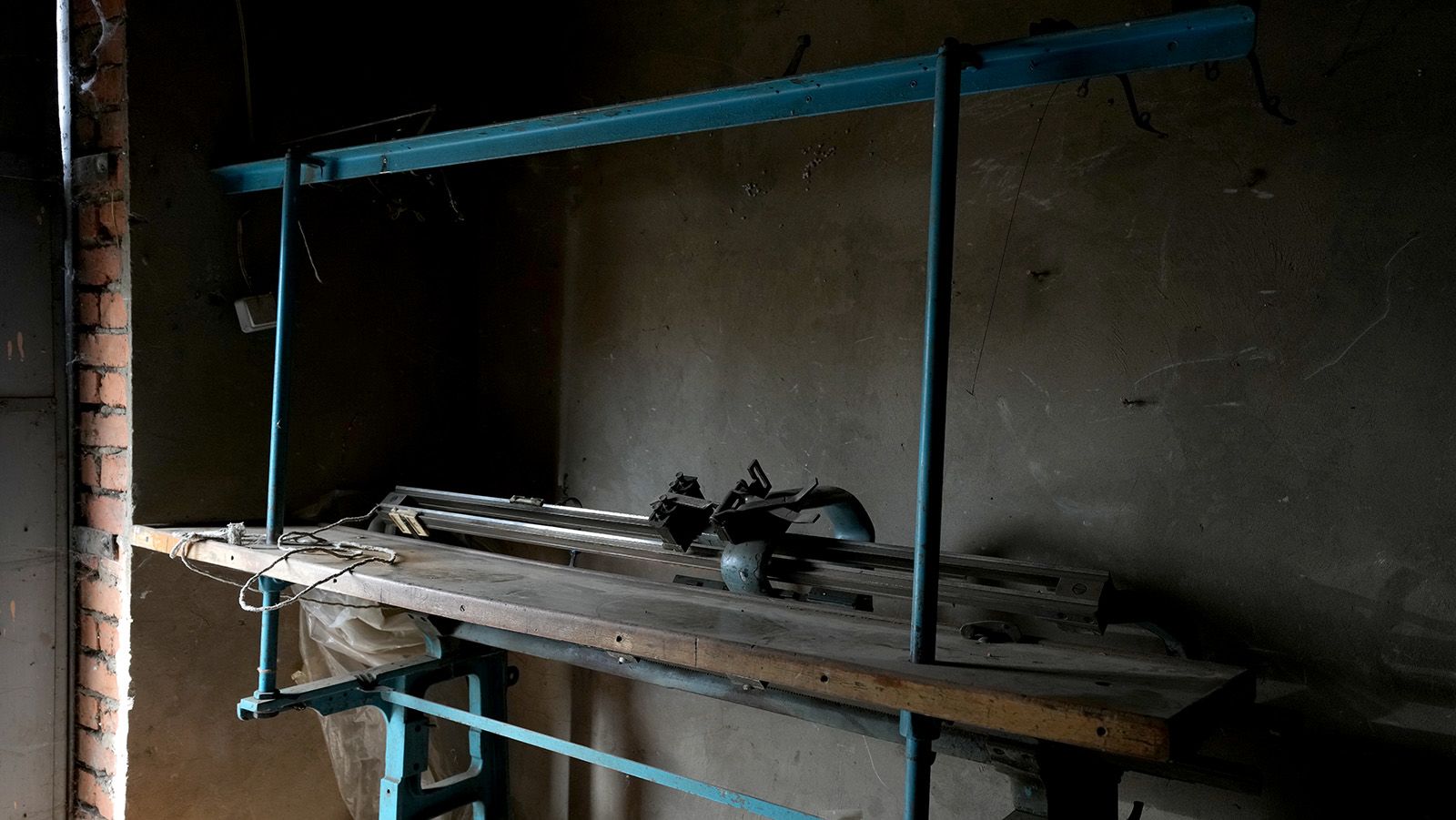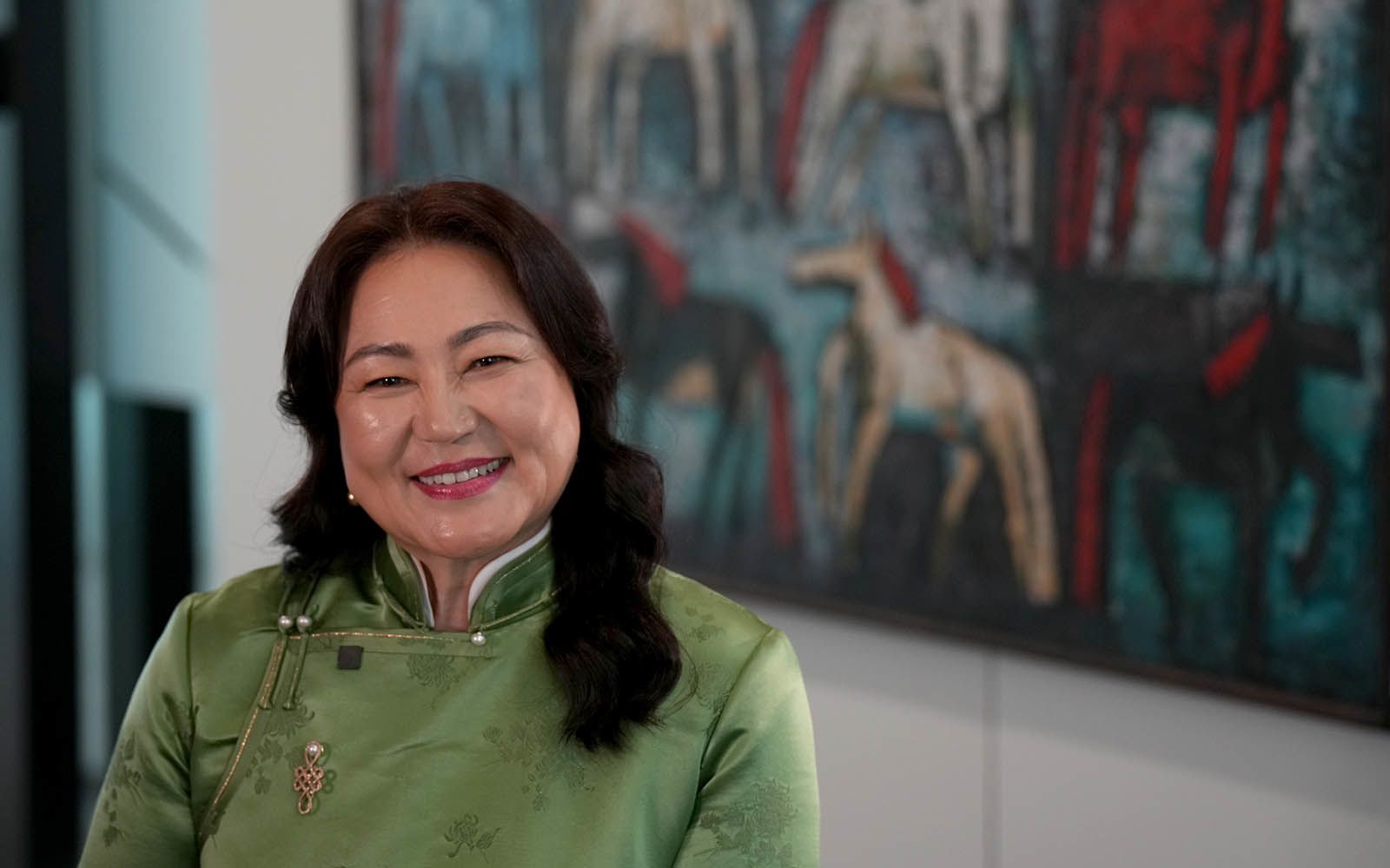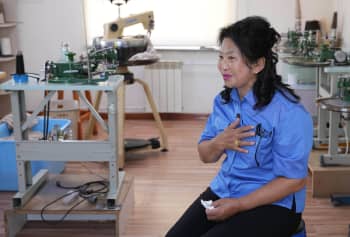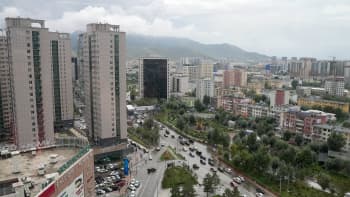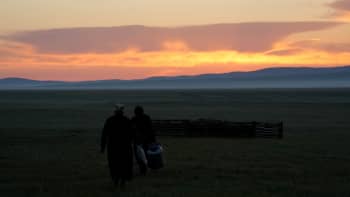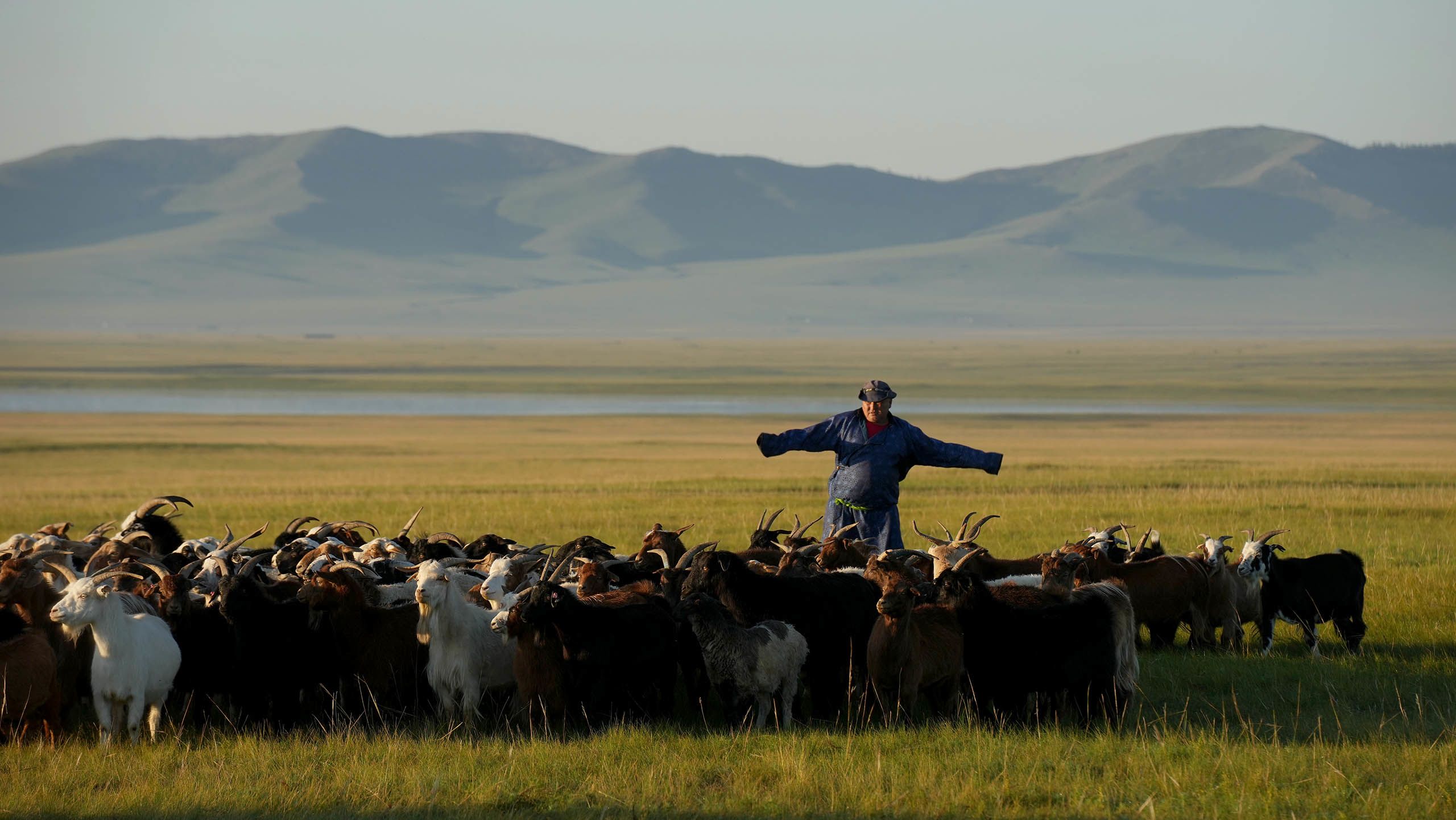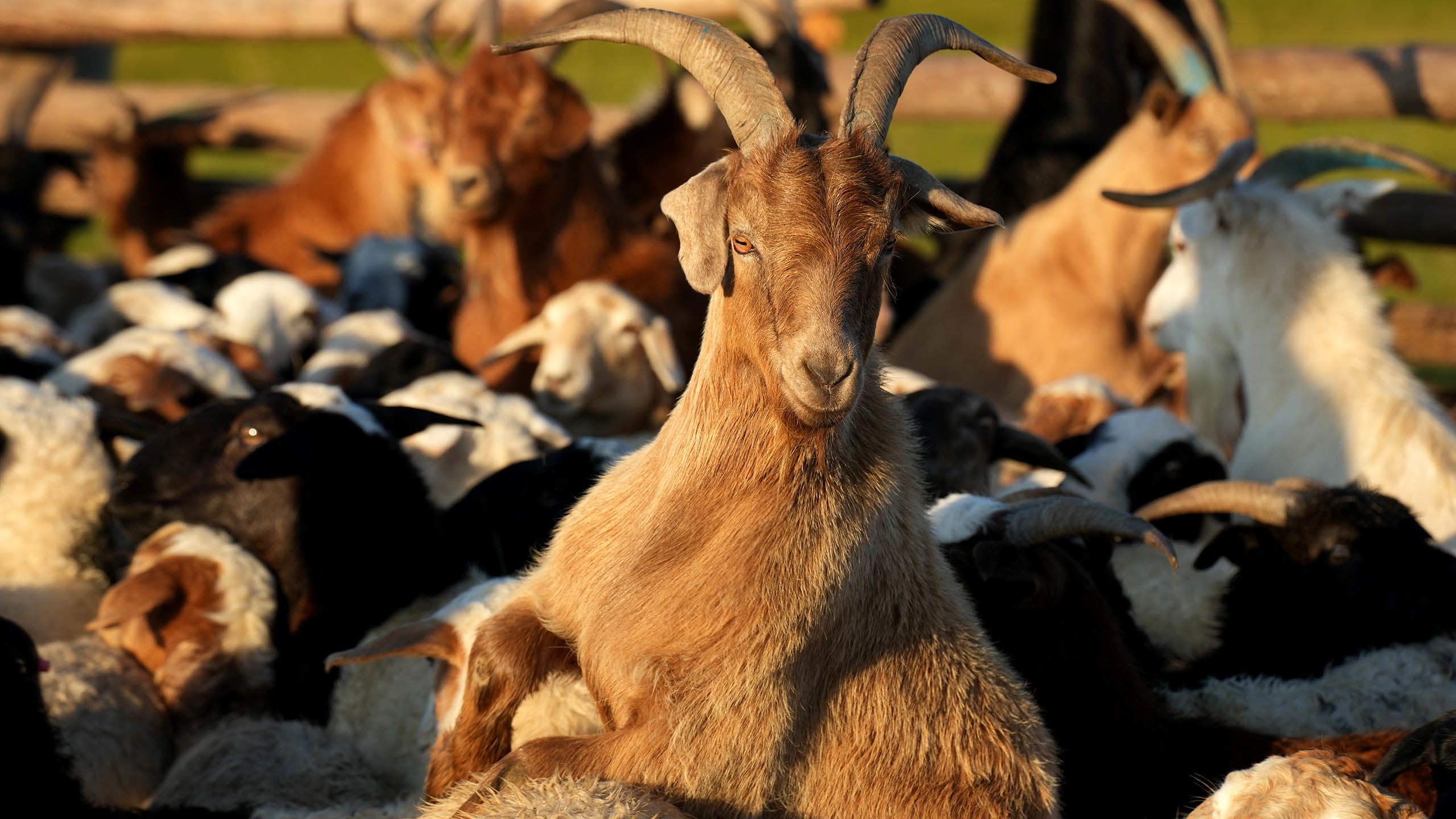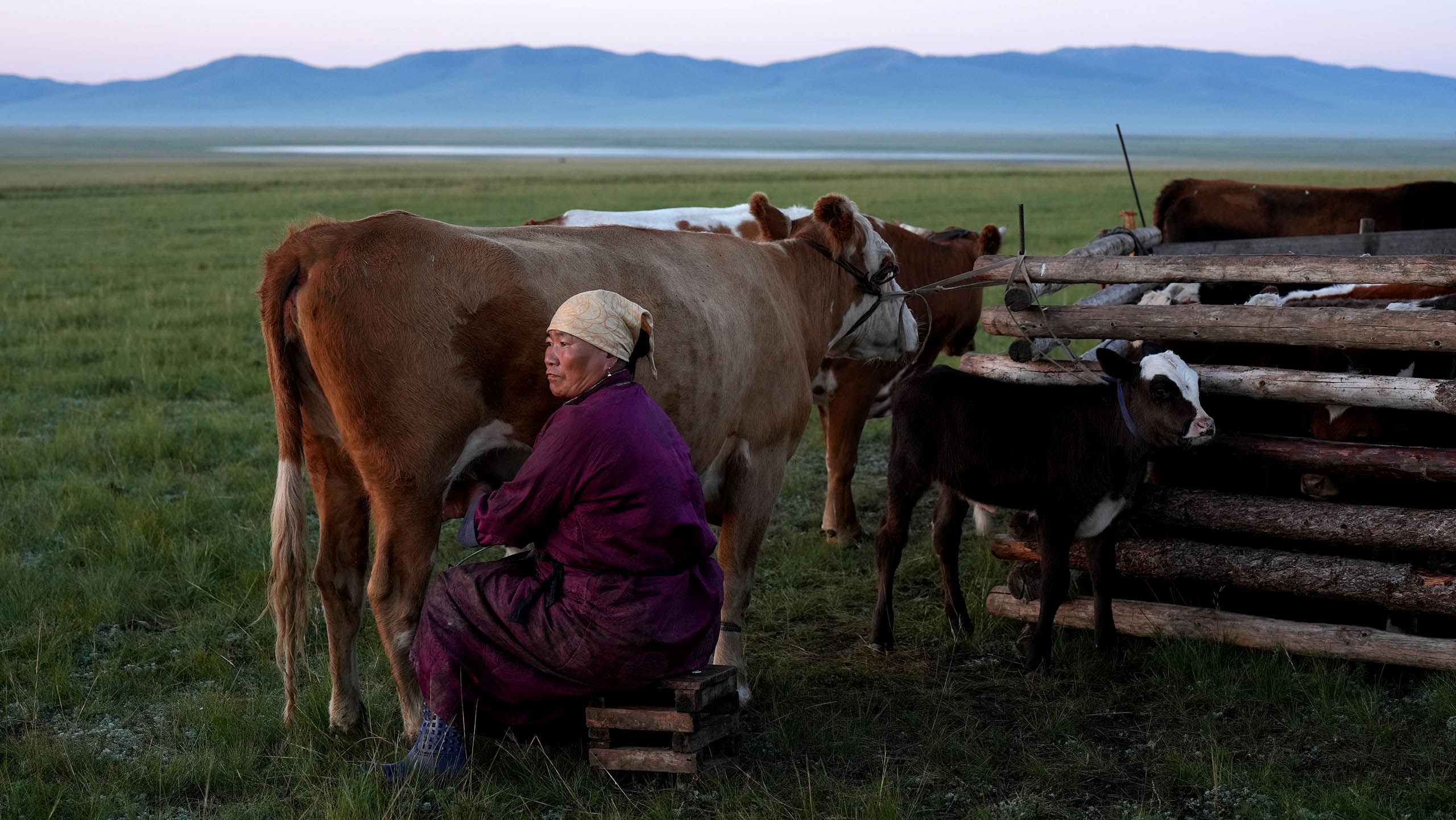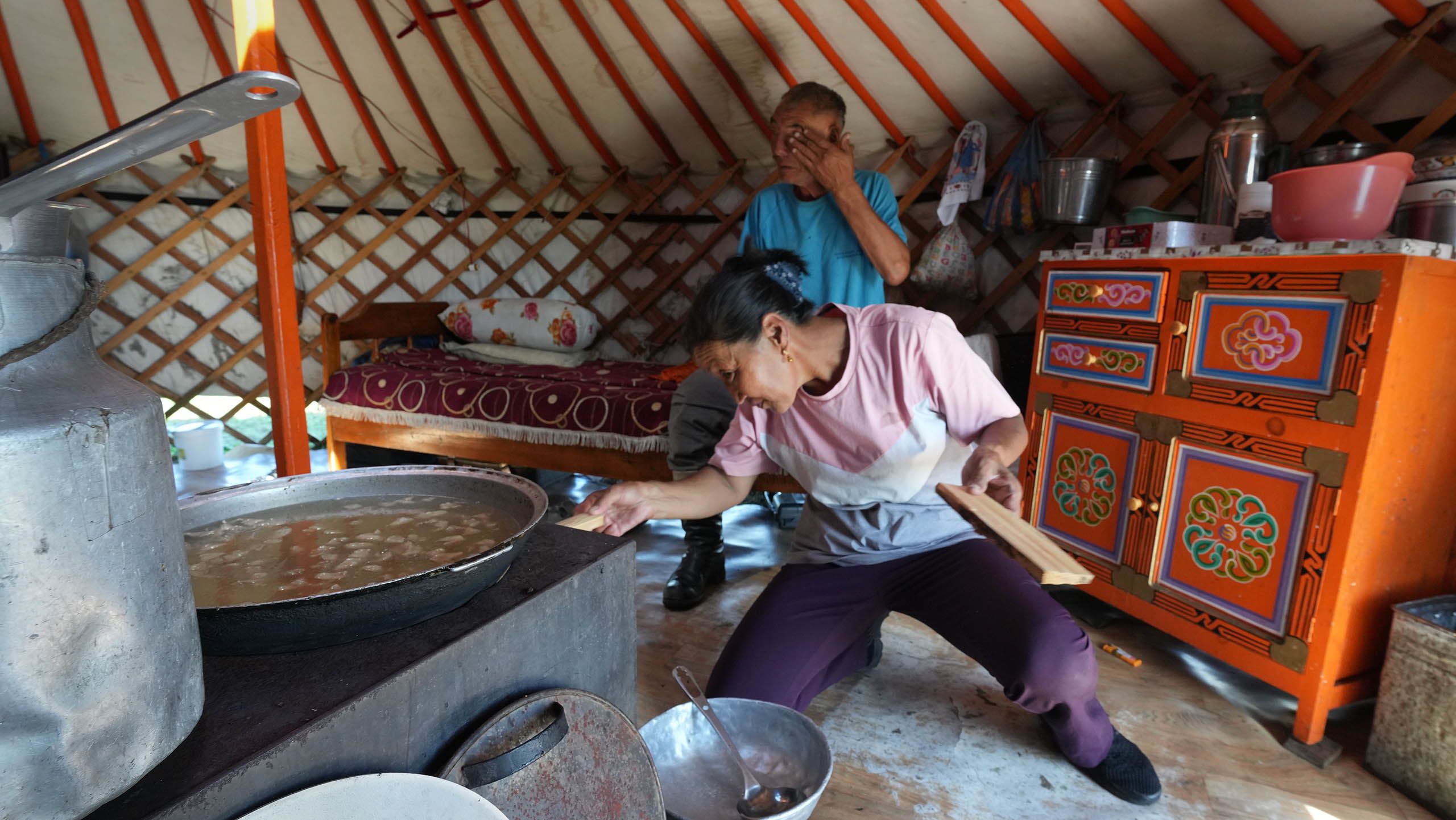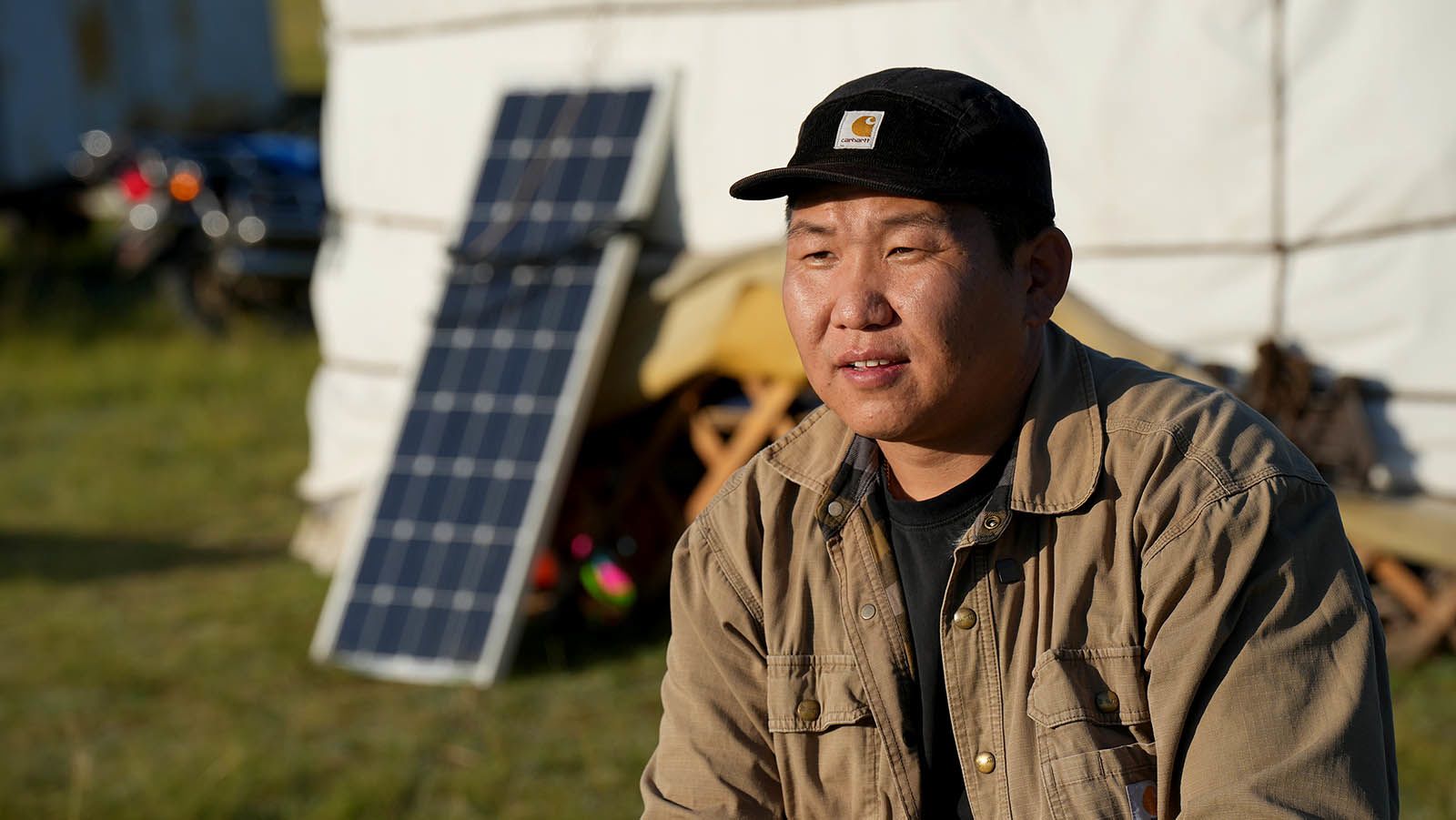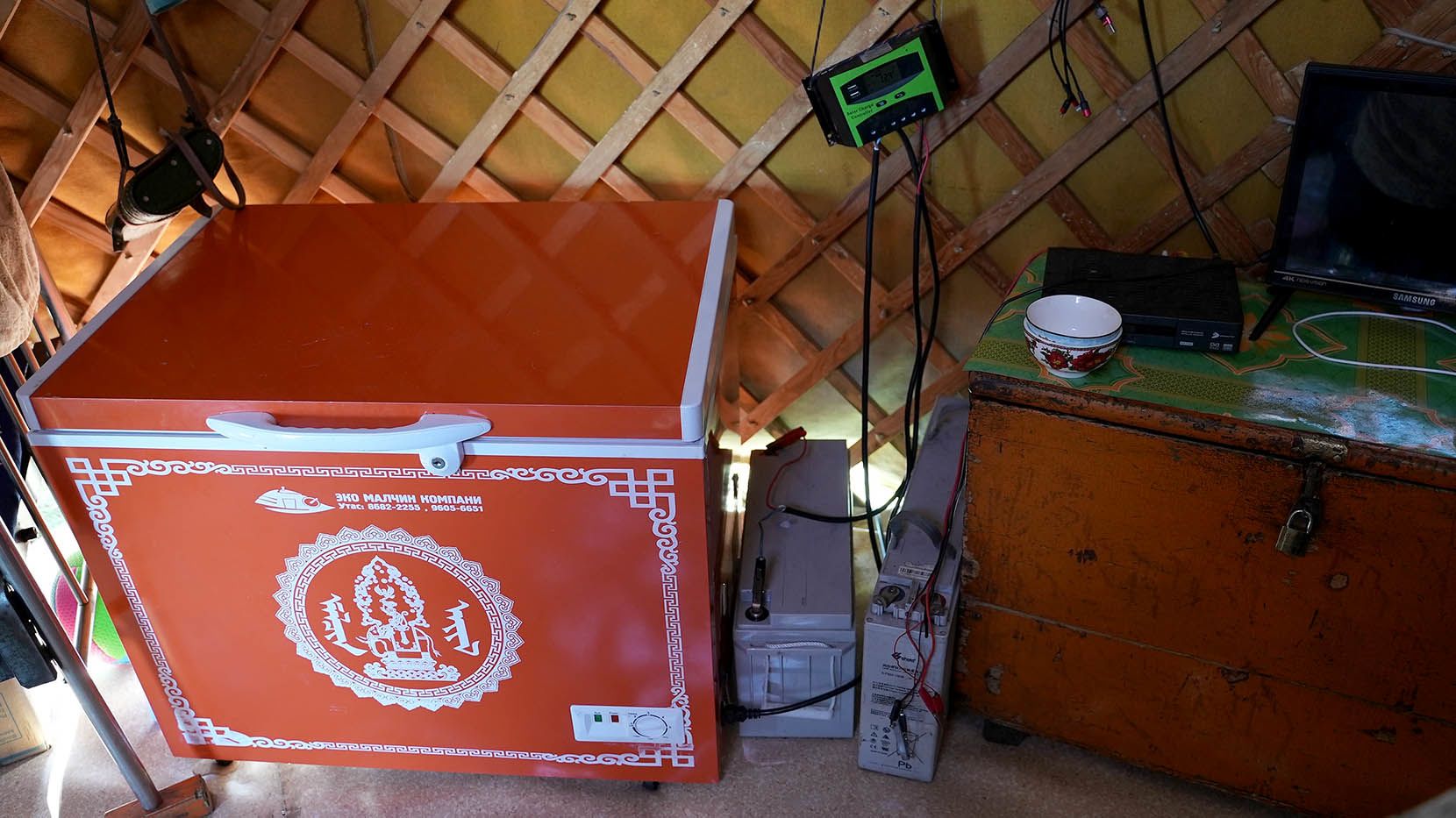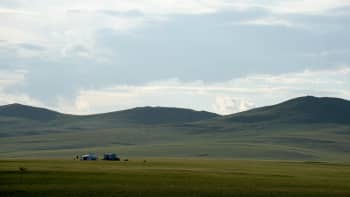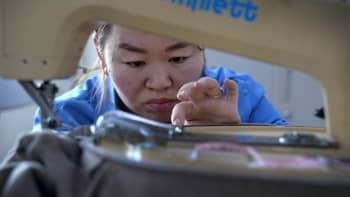From Field to Factory: Mongolia’s Cashmere Production Goes Green
How Mongolia’s first green bond is building a more climate-friendly cashmere industry
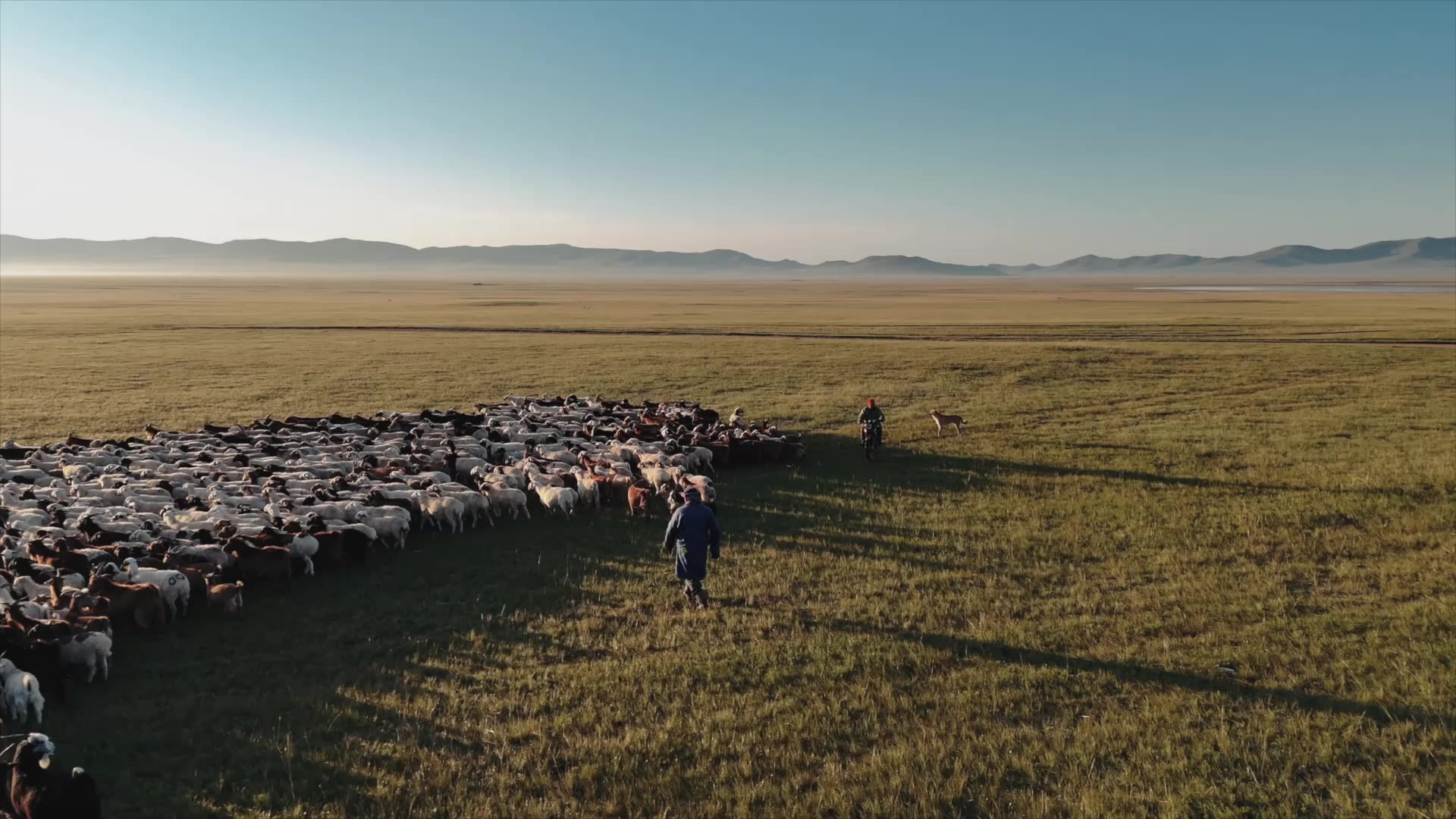
Pumping the foot pedals and rotating the hand cranks of her antiquated weaving equipment never felt like work for Davaasuren Ayursed. The machine was an extension of who she was, she says, because it allowed her to create something beautiful out of thin air, as an artist would. She had learned how to knit commercial garments at a vocational school in Mongolia in the 1980s, and joined a cooperative knitwear factory in Ulaanbaatar, the capital, at age 17. When the factory went bankrupt in 1995, a casualty of Mongolia’s transition to a market-based economy, “It was one of the worst moments of my life,” she remembers.
But one good thing happened on that dark day: each worker could purchase a piece of equipment before the factory closed. She hauled home a weaving machine twice her size. “I had the idea to start my own business, using this machine in my apartment, doing the work that I loved,” she says. “In this vision for my future, I saw myself being very successful.”
Davaasuren has kept the original loom that she used to start her business.
Davaasuren has kept the original loom that she used to start her business.
As she tears up at the memory, Davaasuren glances around the factory—her factory—that produces cashmere clothing for Tumen Suljee LLC, the firm she incorporated in 2007. Tumen Suljee sells affordable knitwear to wholesalers and retailers across Mongolia and exports 20 percent of its inventory. Davaasuren and her son, who is now the CEO, recently made a big decision: they’re expanding the company and drawing up plans for a larger, more modern factory with energy-efficient equipment.
“We want to be a people-friendly and environmentally-friendly company,” she says.
Green loans from Khan Bank, Mongolia’s largest commercial financial institution, are supporting the company through this transition. Khan Bank introduced the country’s first green bond in 2023 to promote a sustainable economy, and proceeds from the green bond have funded a large number of loans for climate-friendly projects, such as this one, according to Munkhtuya Rentsenbat, CEO, Khan Bank.
"Green finance is a priority,” she says, noting Ulaanbaatar’s high levels of air pollution, as well as rising temperatures, declining rainfall, and increasing flooding across Mongolia. These and other negative consequences of climate change create an urgent need for solutions, and long-term loans to clients that prioritize sustainability offer a path forward, she says.
Munkhtuya Rentsenbat, CEO, Khan Bank.
Munkhtuya Rentsenbat, CEO, Khan Bank.
Green bonds are an effective way to attract funding to finance green projects that benefit Mongolia and its people, says Allen Forlemu, IFC Regional Industry Director for the Financial Institutions Group, Asia & the Pacific. However, the market is still in its infancy in many emerging economies, where capital is needed most.
What's a green bond? Learn more here.
“Since green bonds are still nascent in many emerging and developing economies in Asia Pacific, emerging markets such as Mongolia, which issued its first green bond just last year with our support, can benefit from guidance on tapping into the enormous potential of this burgeoning market,” Forlemu says. The global green bond market reached $588 billion issuance in 2023, but with just $46 billion issued in emerging markets outside China, or 8 percent of the total.
IFC invested $15 million in the $60 million, five-year bond to help Khan Bank grow its climate portfolio and strengthen Mongolia’s commitment to reduce greenhouse gas (GHG) emissions by 22.7 percent by 2030. The investment follows IFC's advice to the Mongolian government, which laid the groundwork for the green bond. Khan Bank then developed a Green Bond Framework to make this issuance possible, with support from IFC.
Khan Bank’s subsequent green loan to Tumen Suljee offers a glimpse into how green finance tools can enhance sustainability efforts across company operations—from the practices of the nomadic herders who raise cashmere goats to the energy-efficient factory equipment that ramps up productivity.
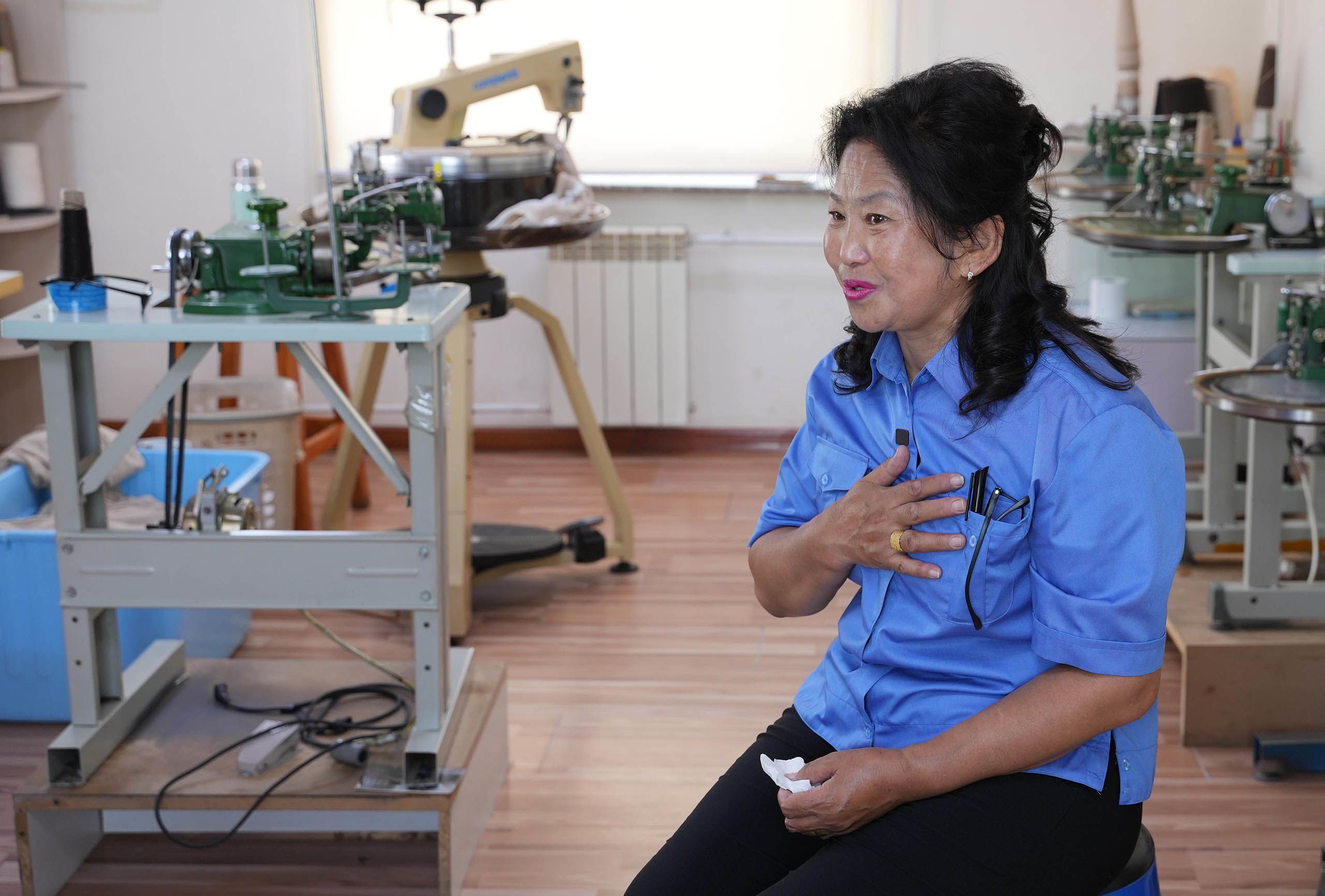

Financial tools such as green bonds and green loans are helping Mongolia's cashmere industry cut greenhouse gas emissions—while strengthening the resilience of the nomadic goat herders known throughout centuries as “guardians of the land.”
Powering productivity
As the sun rises over eastern Mongolia’s Khentii Province, the morning fragrant with the scent of wild thyme and other native grasses, Munkhzul Dulam stoops through the doorframe of his ger, a round, portable one-room home. He’s preparing for another 15-hour day following his herds of goats, sheep, and cattle across the steppe. His daily routine has remained unchanged since he married his wife 34 years ago.
His routine may be the only thing that’s unchanged. The solar panels propped up outside the ger power a freezer that keeps meat fresh in summer, run a small television balancing on a bench, and charge family members’ cellphones. The cellphones are especially important in spring, when Munkhzul fields calls from buyers to coordinate the sale of wool from his 300 cashmere goats.
Spring is the busiest and most lucrative time for the country’s 190,000 cashmere goat herder households, who comprise one-third of the country’s 3.5 million people. Because of the high quality of cashmere fibers from local goat breeds, Mongolia is the second-largest producer of cashmere, with a global market share that is steadily expanding to 40 percent, according to the World Bank.
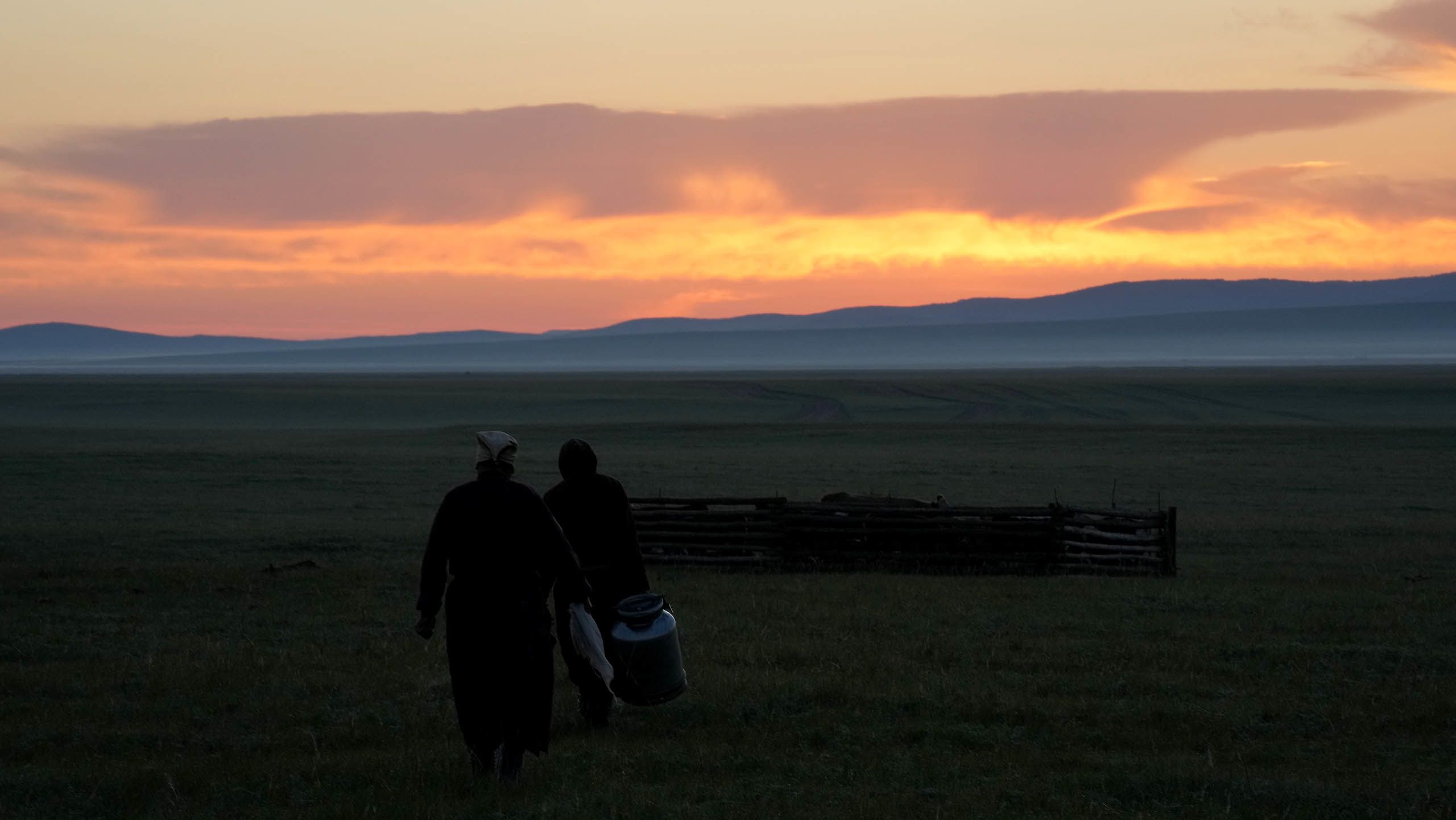
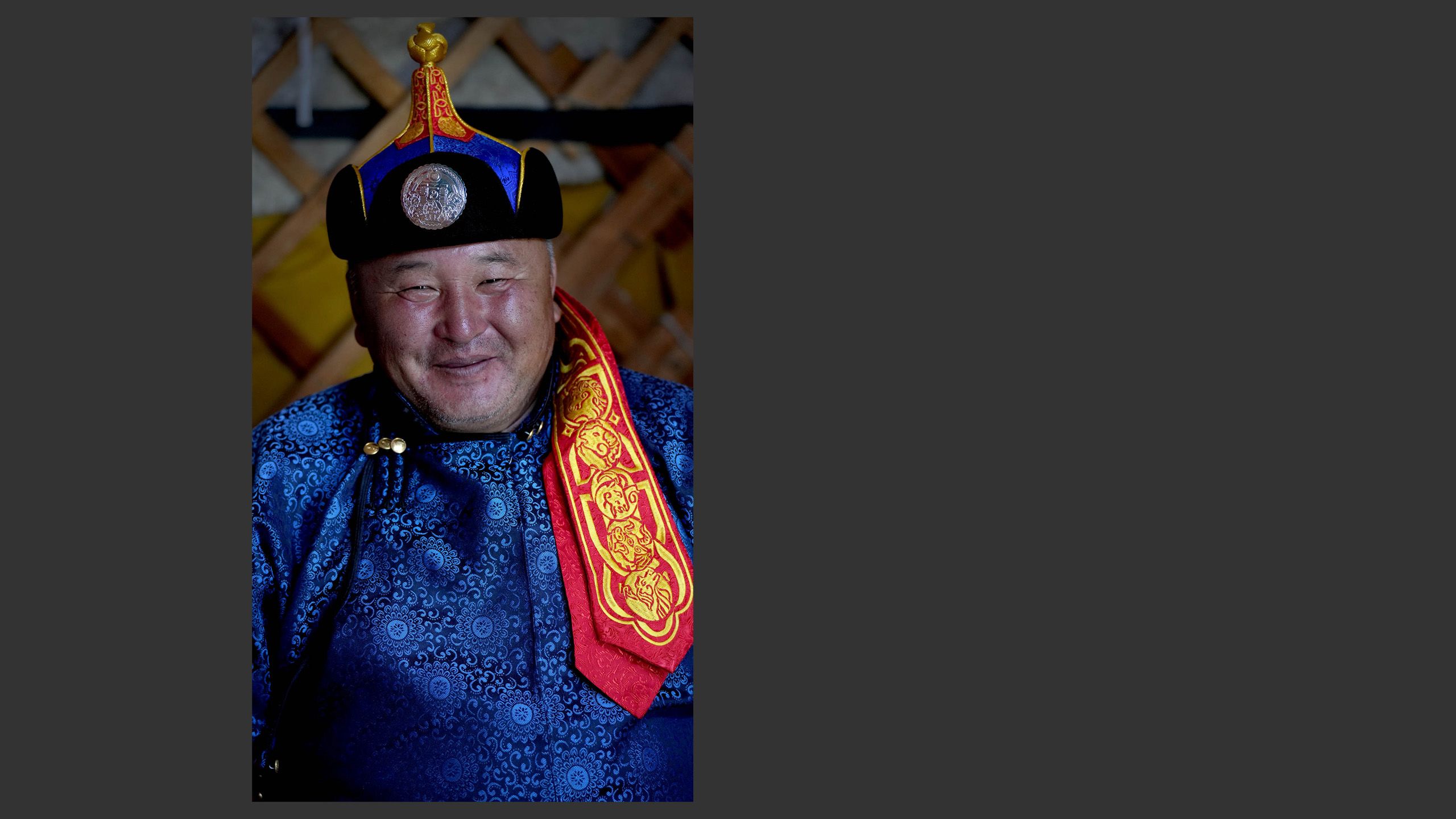
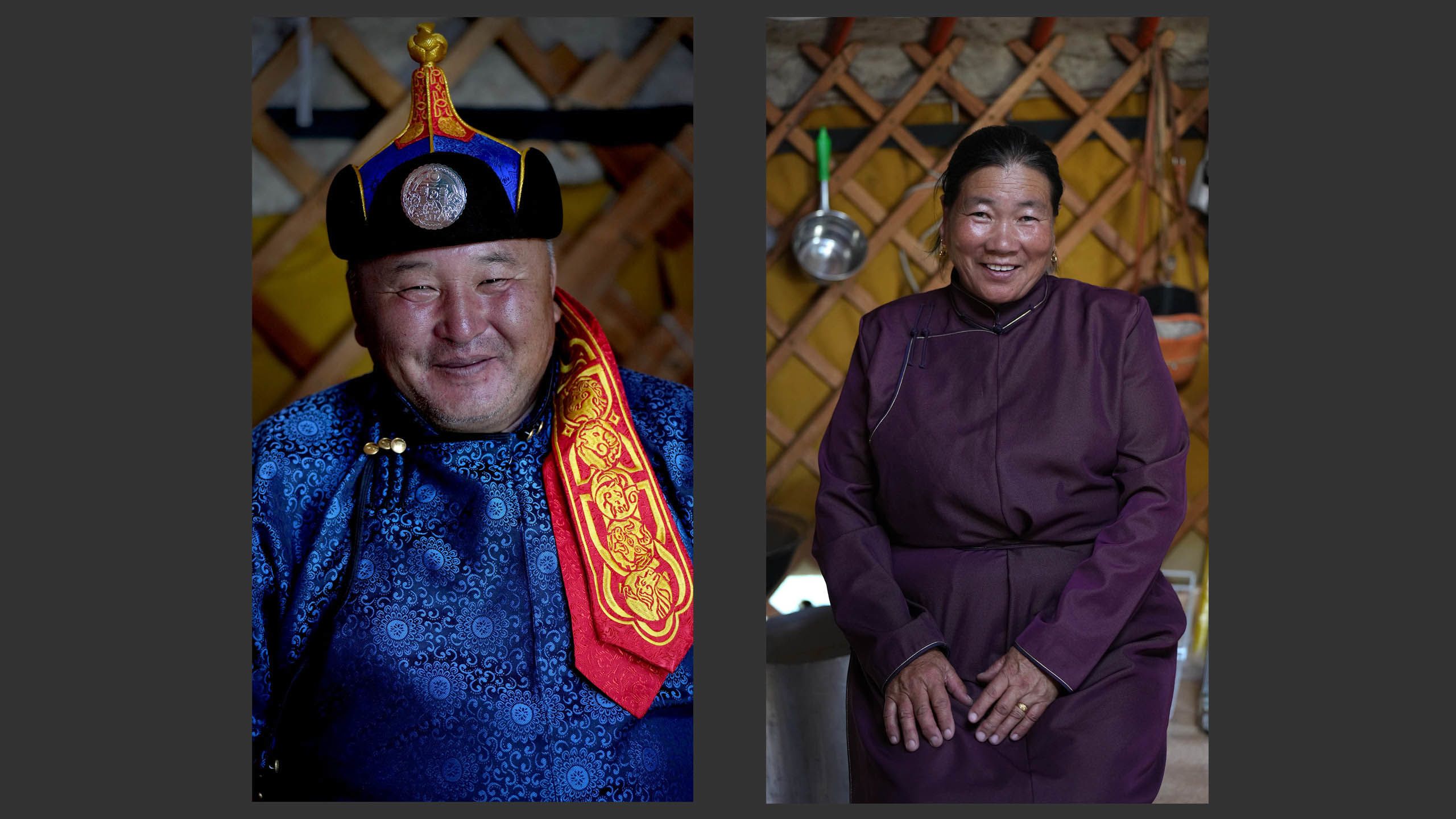
“I’m proud I can contribute to the value chain,” says Munkhzul Dulam, pictured above with his wife, Bayarmaa Badnaabanchin. Munkhzul was recognized with Mongolia’s Champion Herder award in 2018. “My goats help factory workers keep their jobs, and factories contribute to the economy. I’m glad I can do my part.”

In Mongolia’s Khentii Province, 260 km (161 miles) from Ulaanbaatar, Munkhzul Dulam and his family supply raw cashmere to the Tumen Suljee factory.
In Mongolia’s Khentii Province, 260 km (161 miles) from Ulaanbaatar, Munkhzul Dulam and his family supply raw cashmere to the Tumen Suljee factory.
Mongolia's cashmere goats have exceptionally long wool strands to survive the harsh winters. Because of the high quality of cashmere fibers, Mongolia is the second-largest producer of cashmere, with a global market share that is steadily expanding to 40 percent, according to the World Bank.
Mongolia's cashmere goats have exceptionally long wool strands to survive the harsh winters. Because of the high quality of cashmere fibers, Mongolia is the second-largest producer of cashmere, with a global market share that is steadily expanding to 40 percent, according to the World Bank.
Herders earn the bulk of their income from cashmere, though they also own cattle, horses, sheep, and camels. On an average day, they spend 15 hours following and caring for their animals.
Herders earn the bulk of their income from cashmere, though they also own cattle, horses, sheep, and camels. On an average day, they spend 15 hours following and caring for their animals.
Enkhtugs Luvsanin and her husband, Bolor Arur, make a traditional soup in their ger, a round, portable one-room home. Herders move several times a year in search of fresh pasture for their animals.
Enkhtugs Luvsanin and her husband, Bolor Arur, make a traditional soup in their ger, a round, portable one-room home. Herders move several times a year in search of fresh pasture for their animals.
For Tumen Suljee’s CEO (right), herders’ place in Mongolia’s cultural heritage is sacrosanct. One of the best parts of his job is “Supporting the herders who continue to cultivate our country’s land,” he says. “It’s a big joy to see our herders and their families living well.”
For Tumen Suljee’s CEO (right), herders’ place in Mongolia’s cultural heritage is sacrosanct. One of the best parts of his job is “Supporting the herders who continue to cultivate our country’s land,” he says. “It’s a big joy to see our herders and their families living well.”
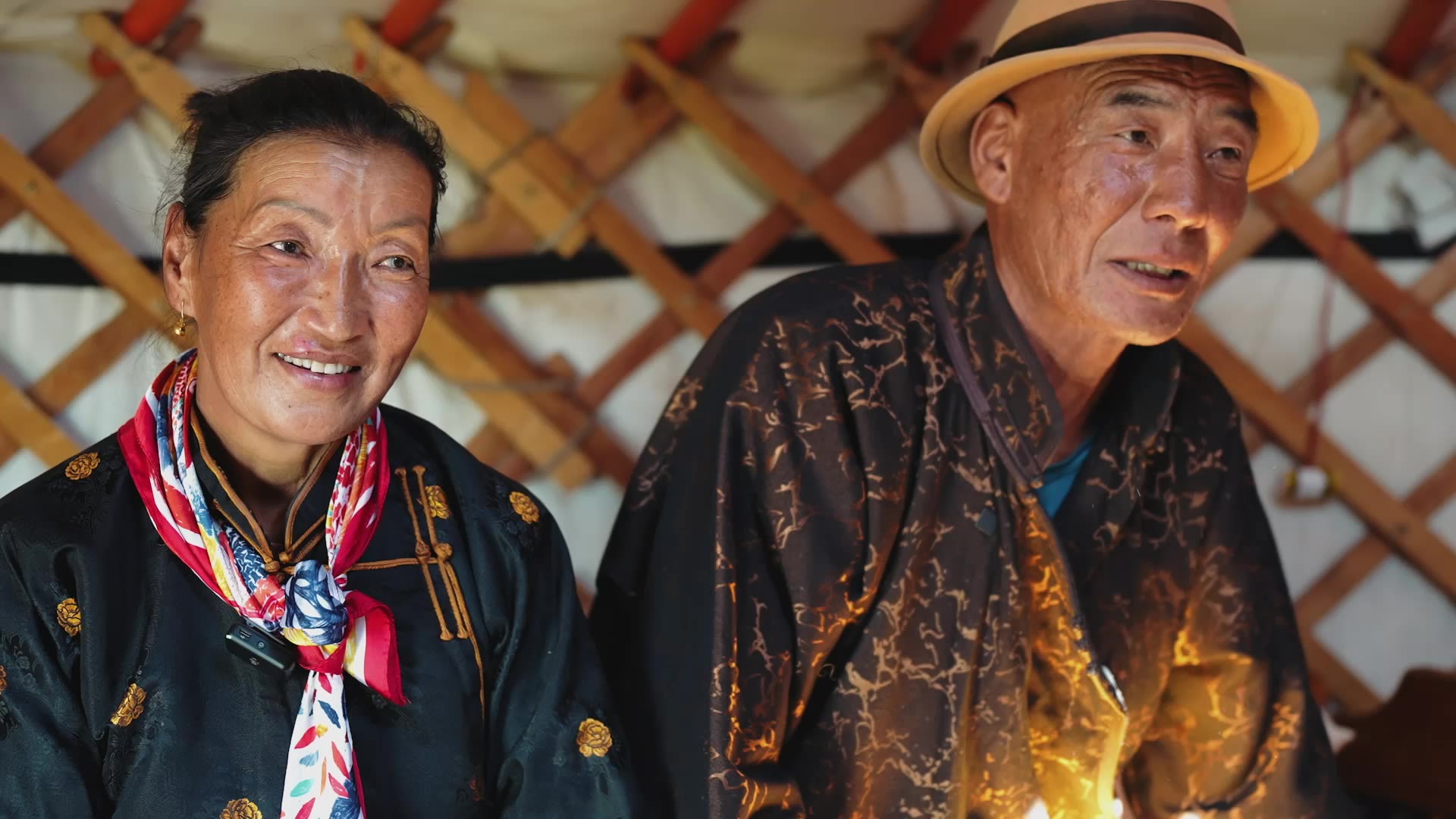
But although Mongolia transitioned to a market-based economy in 1990, its domestic manufacturing and production capacity remains low, characterized by “significant untapped potential.” Because of insufficient processing facilities, about 80 percent of Mongolian cashmere is exported, while only 20 percent is processed locally, according to the United Nations Development Programme.
Companies like Tumen Suljee want to change that, says CEO Namkhaijamts Erdenebat, the son of founder Davaasuren Ayursed. Tumen Suljee requires 13 tons of cashmere annually, and the company works year-round to help herders produce this raw material.
Tumen Suljee CEO Namkhaijamts Erdenebat.
Tumen Suljee CEO Namkhaijamts Erdenebat.
Much of this support enhances the herders’ quality of life while also boosting efficiency. Bolor Arur, another herder who supplies cashmere to Tumen Suljee, says that access to renewable energy sources has benefitted his business.
Payments from Tumen Suljee that originated with Khan Bank’s green loan, along with another Khan Bank green consumer loan designed for herders, made it possible for his family to purchase portable solar panels. The panels power a freezer, which allows the family to eat meat throughout the summer without drying it, as well as an outdoor washing machine, which saves time that used to be spent washing clothes by hand. Charging their cell phones via these panels means that both herders can use mobile banking apps to receive and transfer payments—so they don't have to leave their animals to find a Khan Bank branch in the nearest village.
Indoor freezers like these, powered by solar panels propped outside of the ger, make it possible for herder families to eat meat throughout the summer.
Indoor freezers like these, powered by solar panels propped outside of the ger, make it possible for herder families to eat meat throughout the summer.
As the company’s financial position has stabilized, it has been able to help the herders in other ways. For example, Tumen Suljee pays the herders immediately upon receipt of the cashmere instead of paying them in installments, as some other companies do, Namkhaijamts says. Both herders noted that this is critical to maintaining their animals.
In addition, when there is a natural disaster, such as last year's dzud (an extreme cold event, linked to climate change, that prevents livestock from reaching grass), the company offers advance payments to help herders purchase animal feed so there is no interruption in productivity. The company also donates vaccines and medicines for cashmere goats and collaborates with herders to prevent overgrazing of the rangelands, to promote sustainability of the wild grasses and plants.
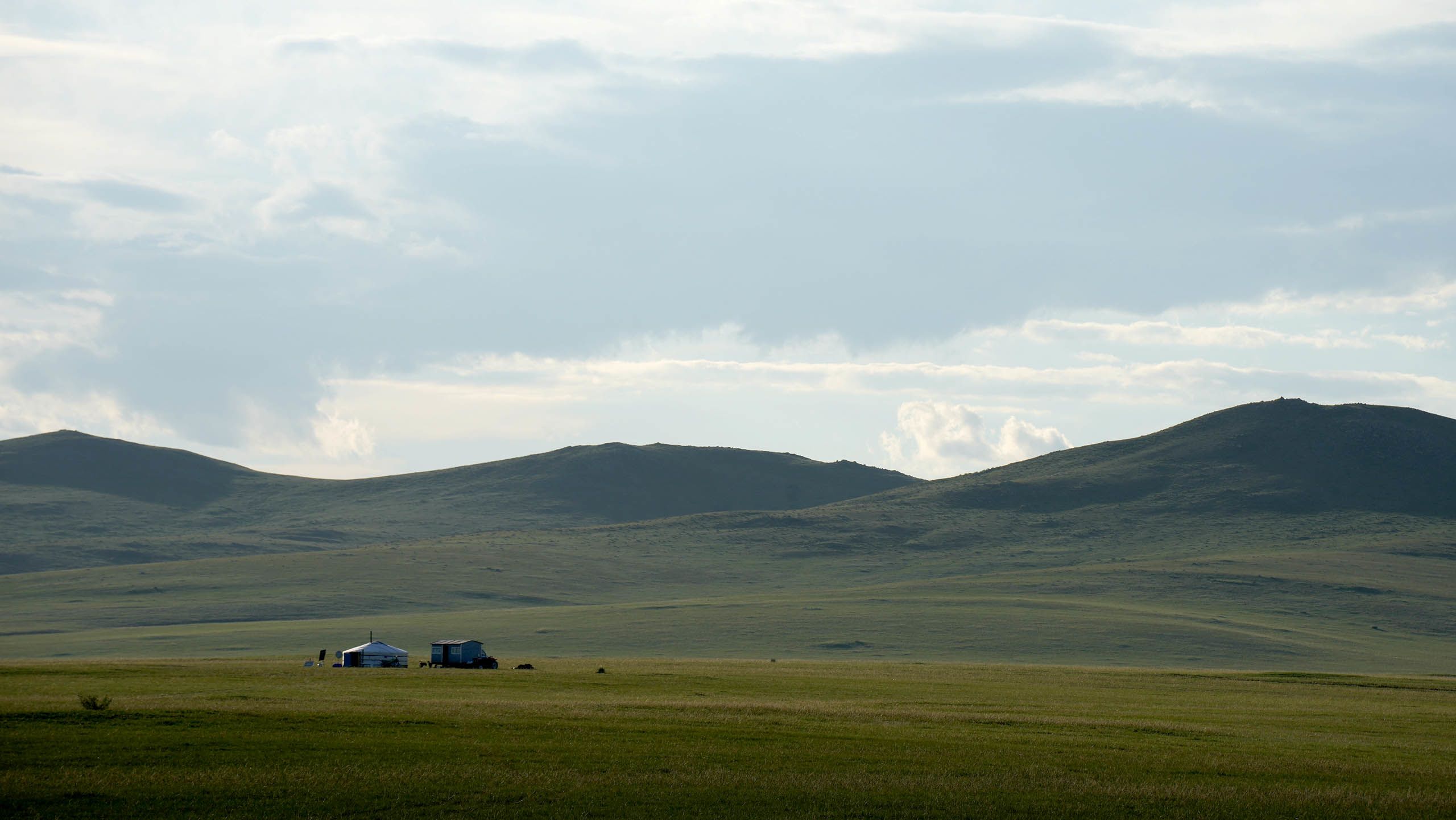

From field to factory
Back at the Tumen Suljee factory in Ulaanbaatar, the whirring of weaving equipment and churning of washing machines means that a shipment of cashmere has arrived. Every square foot of the two-story building is packed with bags of raw and processed fiber, multiple pieces of machinery, stacks of finished clothing, and packaging materials.
Both Namkhaijamts and his mother, who is now the company’s Director General, work from small offices next to the main factory floor. That’s where they spoke, in 2012, about the future of the company.
“I was getting older, my husband had died, and I didn’t want my sons to be responsible for a business they didn’t care about if there was something else they wanted to pursue,” she says. “It was my life’s work, but it didn’t have to be theirs.”
But Namkhaijamts and his brother, a business student in China, decided that cashmere production would be their life’s work, too. Though their mother had started the firm to sustain the family, its success meant that they could think on a much larger scale.
To start, Namkhaijamts, who had earned a computer science degree, sketched out a plan to automate the business; at that time, nearly everything operated manually, even the sewing machines. Together, the family resolved to modernize and export the “Made in Mongolia” label around the world.
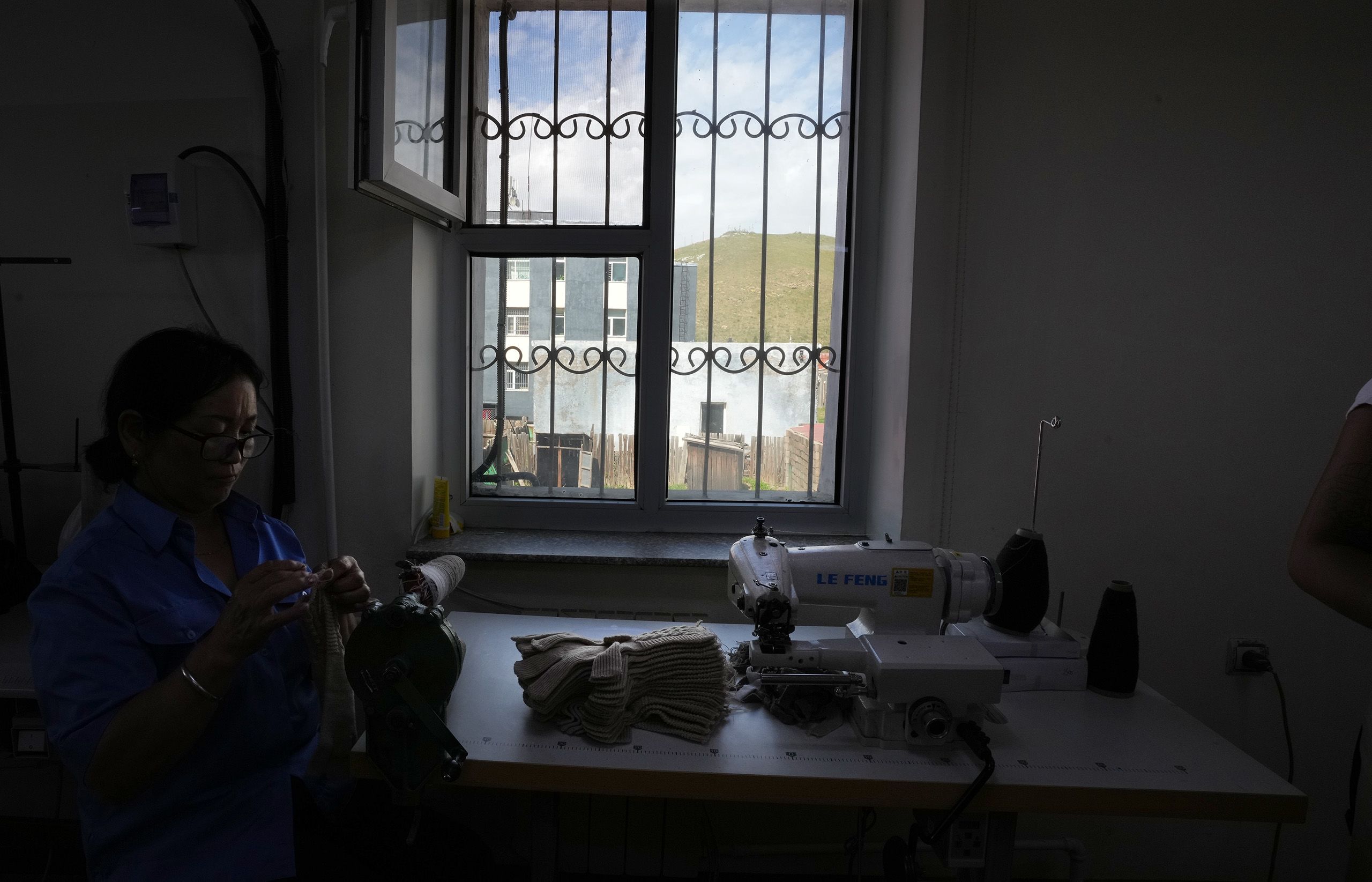
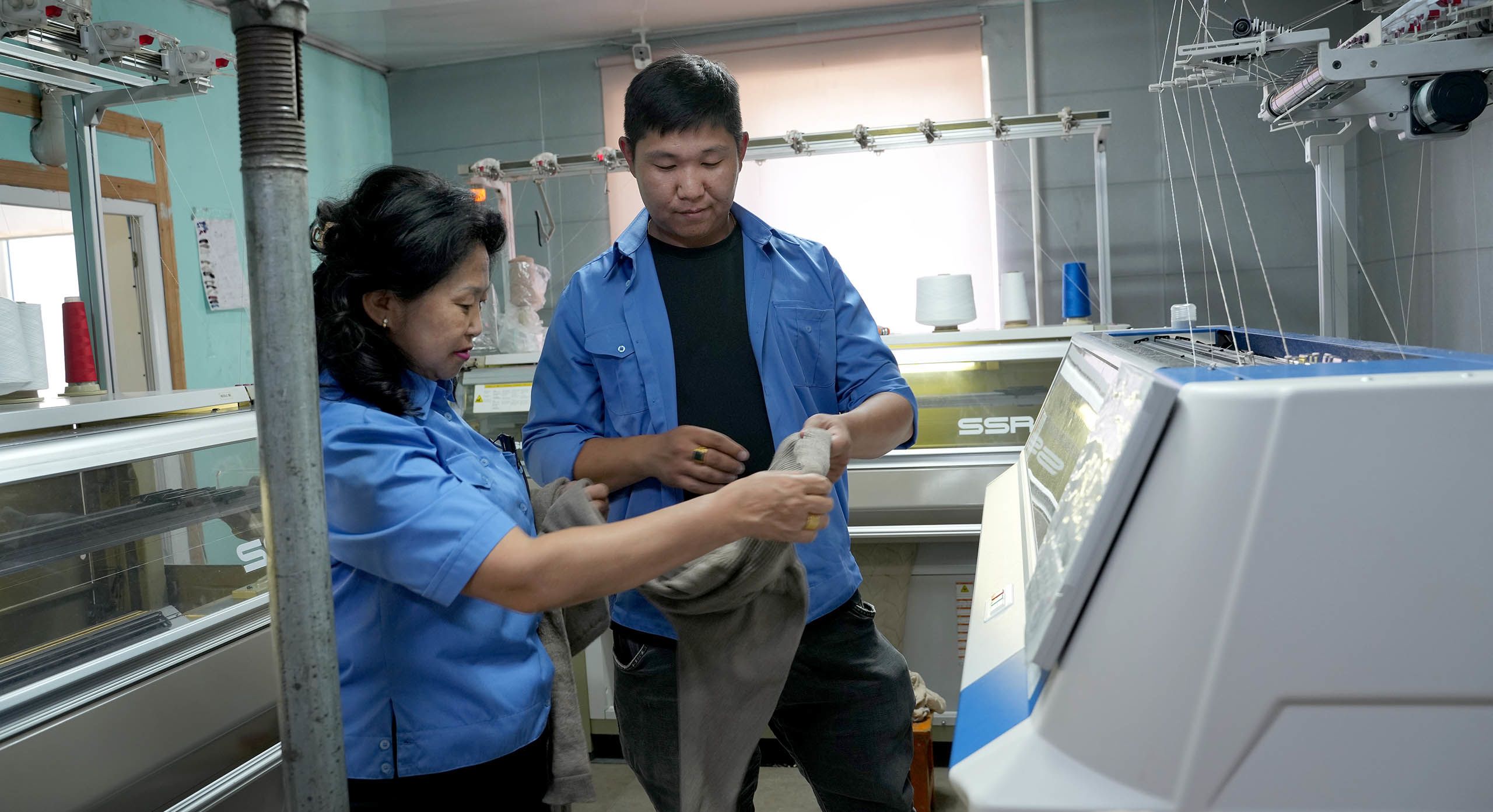
As Namkhaijamts began working with Khan Bank, which has granted the company about 10 loans since its founding, the new green loan program piqued his interest.
“I saw how energy-efficient equipment could transform the business, and I only choose energy-efficient machines now,” he says. “As the CEO, and as a Mongolian, I worry about climate change. We all have to do our best to reduce CO2 emissions.”
The green loan allowed him to purchase a $70,000 “finisher” that compresses two weaving and sewing processes into one single process, producing seamless, ready-to-wear sweaters, leggings, gloves, hats, and other garments. It will cut energy consumption per unit of clothing by 21 percent, while saving materials and allowing the company to diversify its product line.
New, energy-efficient equipment will allow Tumen Suljee to diversify its line of cashmere clothing.
New, energy-efficient equipment will allow Tumen Suljee to diversify its line of cashmere clothing.
The new machine will also increase the company’s productivity by 90 percent, which means that it can purchase more cashmere from Mongolia’s herders and hire additional workers at the factory.
Providing Mongolian workers with jobs so they don’t have to migrate to other countries for employment inspires Namkhaijamts to keep expanding his family’s cashmere business. With the new, energy-efficient equipment, “We can help workers increase their skills while growing the country’s manufacturing capacity and helping the environment,” he says. “The next generation will develop and prosper.”

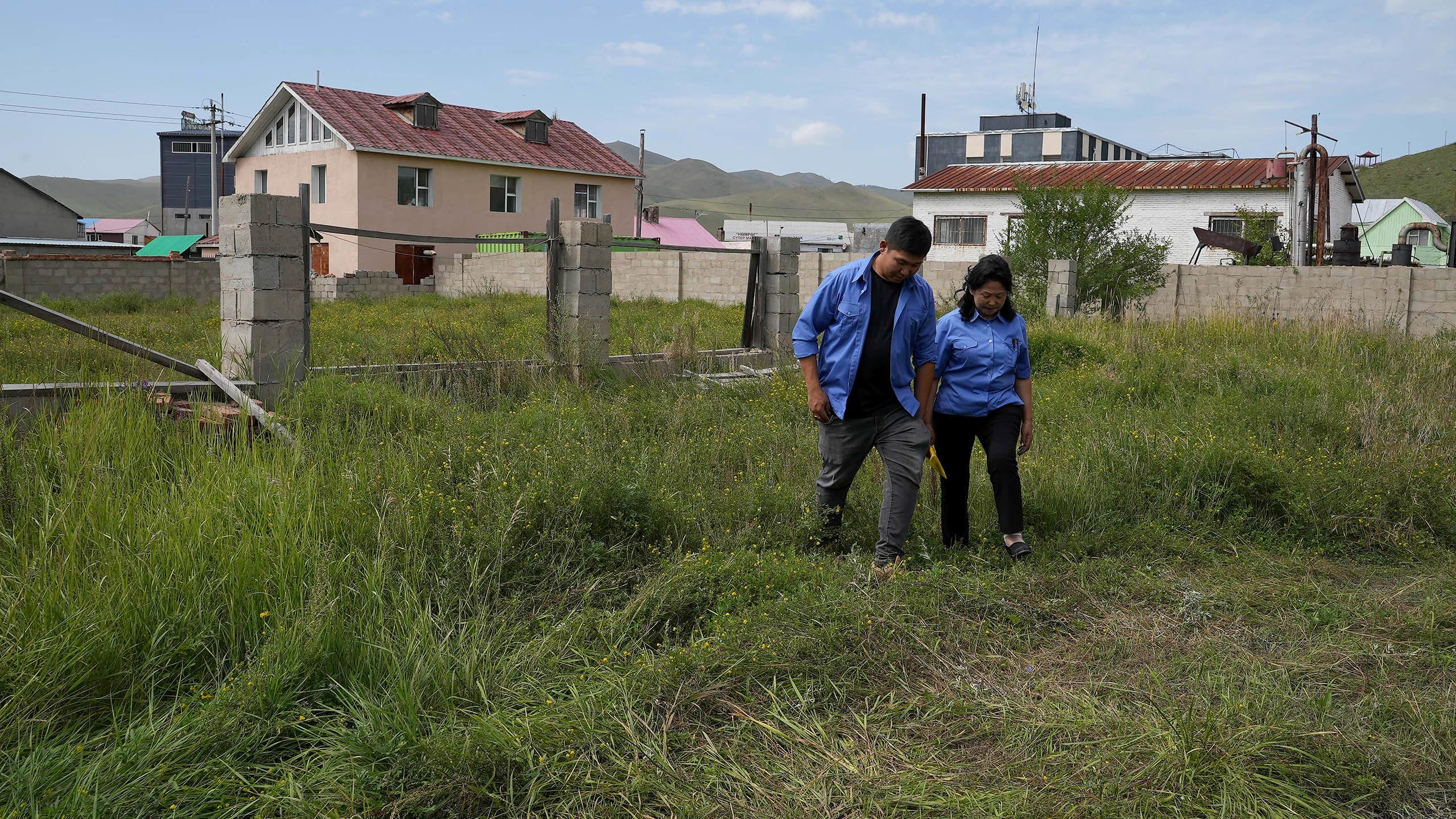
IFC’s anchor investment in Mongolia’s first green bond has helped attract $45 million from international investors, including $35 million from FMO, the Dutch entrepreneurial development bank, and $10 million from MicroVest Capital Management. IFC also helped Mongolia develop and adopt the Environmental and Social risk management requirements for commercial banks. IFC, with support by the Government of Japan through its Comprehensive Japan Trust Fund (CJTF), supported the formulation of Mongolia's Green Bond Regulation and Guideline documents, enabling the issuance of green bonds in the local market.
Published October 2024

